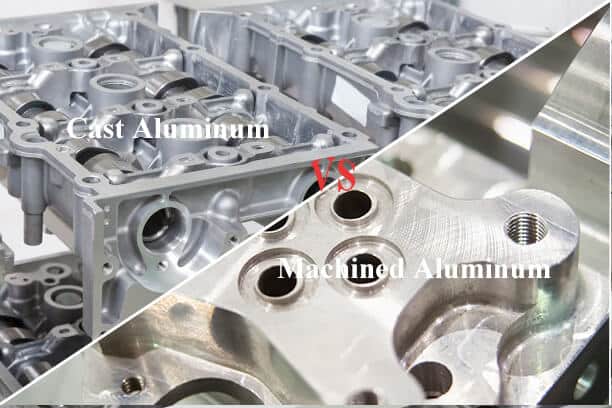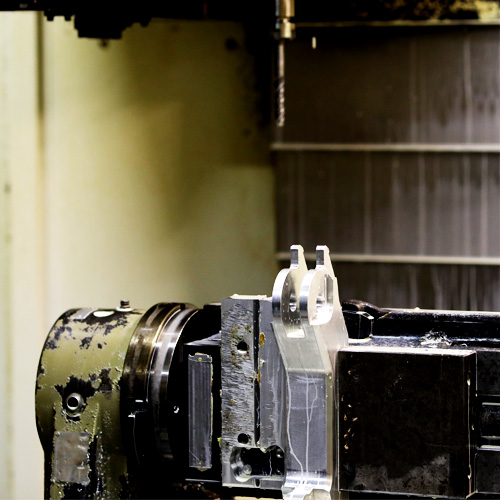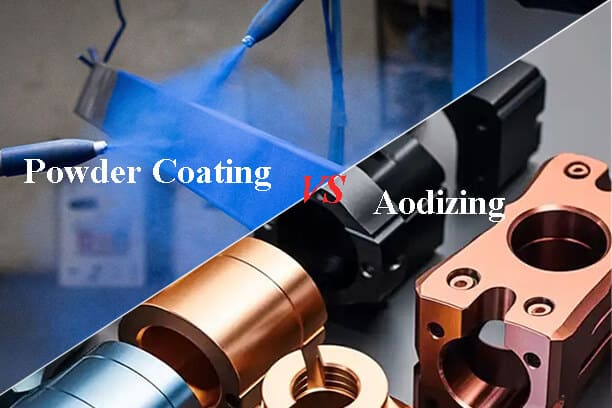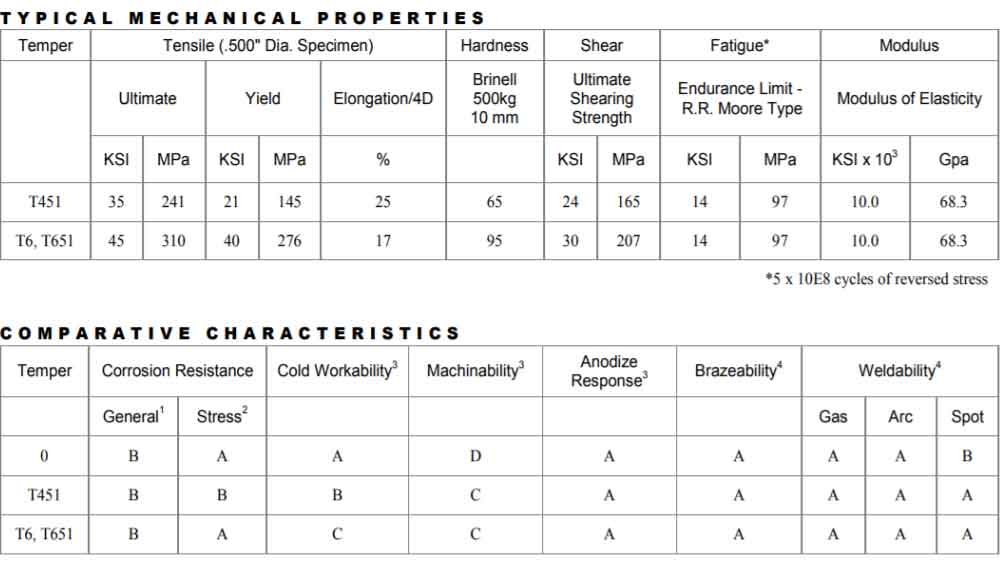As a versatile metal with high performance and excellent properties, aluminum is commonly used in CNC machining and die casting processes to produce machined aluminum and cast aluminum respectively. Both aluminum products have their unique benefits and can be used for various applications. But what are their characteristics and which one is better?
Machined aluminum is ideal for projects that demand precise and accurate results, with a need for tight tolerances and intricate parts. On the other hand, cast aluminum is better suited for larger parts that are less intricate and when strength and durability are crucial.
In this article, we will explore the differences between machined aluminum and cast aluminum to ensure you make the best choice for your specific projects.
What is Machined Aluminum?
Machined aluminum refers to CNC machining of aluminum parts, typically involving turning and milling. CNC milling is the preferred method of machining due to its ability to handle complex shapes.
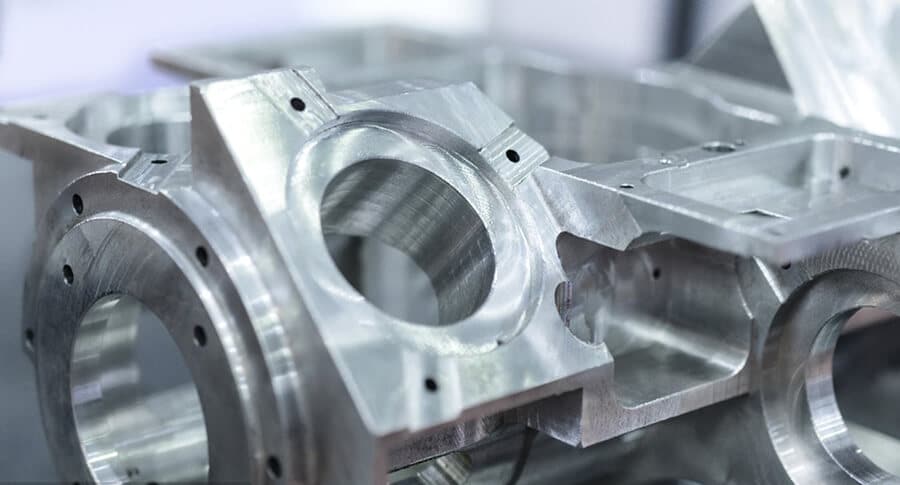
CNC machines can create unique and high-quality aluminum prototypes with exceptional properties, making these parts suitable for a wide range of applications. Machined aluminum can be made from various alloys, including:
- Aluminum 6061: Among the various aluminum alloys, Aluminum 6061 stands out as the most popular choice. This is primarily due to its impressive mechanical capabilities, including strong strength, excellent weldability, ability to withstand harsh conditions, and remarkable flexibility.
- Aluminum 7075: While not as widely used as Aluminum 6061, Aluminum 7075 offers exceptional resistance to fatigue and wear. However, its higher cost and unsuitability for welding projects are important factors to consider when choosing this alloy.
- Aluminum 2024: Aluminum 2024 finds significant application in the aerospace and military industries. It boasts commendable mechanical properties, such as high tensile strength and excellent resistance to wear and tear. Nevertheless, this alloy has limitations in terms of weldability and susceptibility to corrosion.
- Other alloys available for CNC machining include aluminum 2014, aluminum 5052, and aluminum 6063.
What is Cast Aluminum?
Cast aluminum is produced by melting a solid block of aluminum alloy and then shaping it into the desired products through a process called “casting.” This casting process is commonly performed using a die-casting machine. There are several casting methods, including die casting, sand casting, shell molding, and plaster casting.
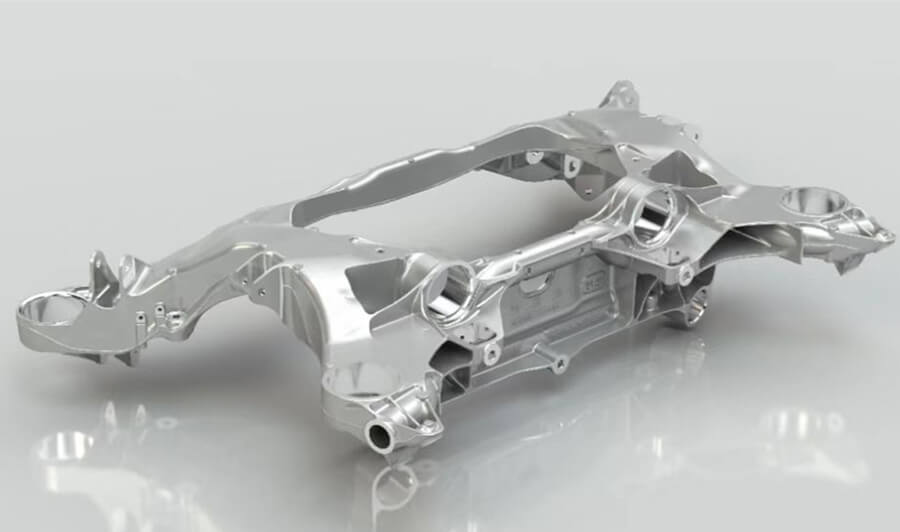
Aluminum is well-known for its lightweight properties, and cast aluminum is even lighter than wrought iron. Additionally, it is much more cost-effective and easier to work with. Cast aluminum finds frequent usage in components such as engine blocks, connecting rods, gearboxes, and other parts that do not require high precision. The automotive and aerospace industries extensively utilize cast aluminum due to its affordability and ease of use.
The common aluminum alloys employed in the casting process are as follows:
- A380 alloy: This alloy is known for its lightweight nature and excellent performance at high temperatures. It is particularly well-suited for creating complex parts, thanks to its remarkable durability.
- A383 alloy: A383 demonstrates good heat conductivity and has the ability to withstand corrosion. However, its properties in these aspects are slightly lower compared to the A380, especially regarding durability.
- A360 alloy: This alloy exhibits high ductility and superior resistance to corrosion, surpassing both A380 and A383 in these aspects. It is also advantageous for producing complex parts. However, it is worth noting that A360 is more challenging to cast compared to the previously mentioned alloys.
Machined Aluminum vs Cast Aluminum: Their Difference
Both machined aluminum and cast aluminum possess exceptional properties, each with its own distinct advantages and disadvantages that dictate their suitability for different applications. Here is a list of factors to consider when deciding whether to use machined aluminum or cast aluminum:
1. Aluminum Grades
Different manufacturing processes may require different types and grades of aluminum to realize the optimal results. CNC machining commonly utilizes aluminum 6061, 6063, 7075, and 2024, whereas casting predominantly employs A360, A380, and A383 alloys.
2. Appearance
The process of creating cast aluminum is similar to injection molding, allowing for the production of various shapes and designs. A prime example is the die-cast aluminum shell commonly used in street lamps. In contrast, machined aluminum typically maintains an equal cross-sectional shape with minimal alterations. Examples of this include bulb lamp heat sinks and aluminum profiles used in doors and windows.
3. Cost
The cost of machined aluminum and cast aluminum is relative to multiple factors, including production volume, machining techniques, labor costs, material prices, and tooling expenses.
In general, machined aluminum tends to be more expensive than cast aluminum. However, it is crucial to carefully analyze the cost and pricing based on the specific circumstances and intended application.
4. Finishing
When it comes to surface finishing, both machined aluminum and cast aluminum offer their own unique benefits. Machined aluminum is known for its ease of polishing and can be meticulously transformed into a highly reflective, mirror-like finish. This makes it an excellent choice for individuals seeking a particularly shiny component.
On the other hand, cast aluminum is more readily compatible with the anodizing process and can be dyed in a wide range of colors. This makes it an ideal option for those needing a part with a distinctive and personalized appearance.
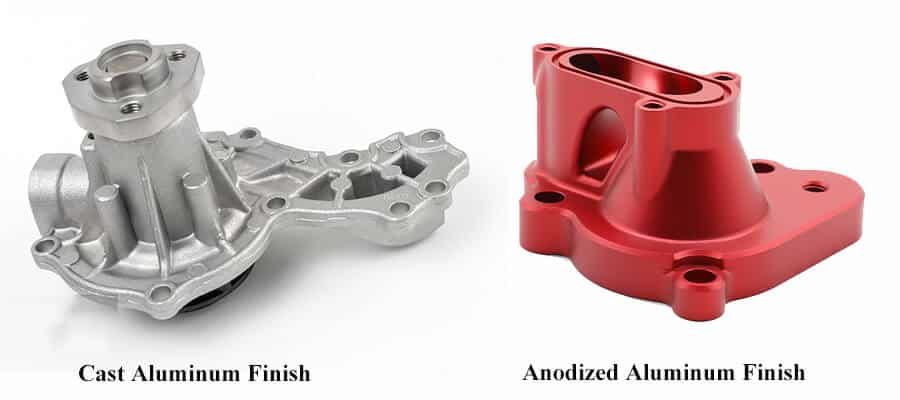
5. Output Capacity
Cast aluminum is well-suited for high-volume production, while machined aluminum tends to have lower production rates. If a project involves the need to produce 1,000 parts or fewer per day, machined aluminum is a suitable choice. On the other hand, for projects requiring the production of approximately 10,000 parts, cast aluminum would be the preferable option.
6. Thermal Conductivity
The general thermal conductivity of cast aluminum is approximately 90 W/mK, whereas machined aluminum has a higher thermal conductivity ranging from 180 to 190 W/mK. This indicates that machined aluminum is more suitable for applications that demand excellent heat dissipation, as it can conduct heat nearly twice as effectively as cast aluminum.
7. Application
Die cast aluminum finds extensive application in various industries, including automotive, street lighting, and even mobile devices. In contrast, machined aluminum is commonly utilized in the manufacturing of downlights, ceiling lamps, doors, windows, etc.
What are the Benefits of Machined Aluminum?
Machined aluminum is widely utilized across multiple industries due to its advantageous properties. Here are some benefits of applying CNC machining for aluminum parts making:
Intricate Shapes and Accuracy
By utilizing CNC machining processes such as milling and turning, aluminum can be shaped into intricate and elaborate designs. These techniques are known for their ability to produce parts with tight tolerances, precision, and accuracy. As a result, aluminum parts that have undergone CNC machining are ideal for applications that demand exceptional precision and accuracy, such as automotive and aerospace components.
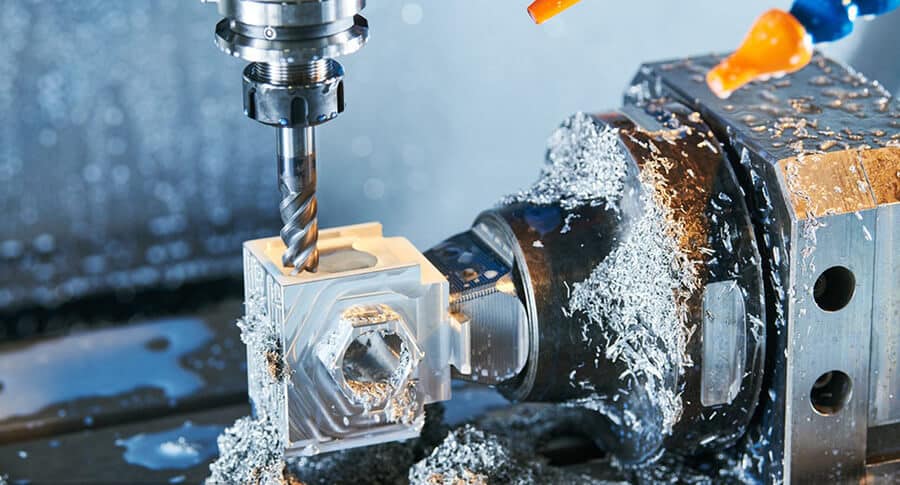
High Corrosion Resistance
Machined aluminum parts exhibit excellent resistance to corrosion, thanks to the formation of a protective layer of aluminum oxide when subjected to challenging environments. This protective layer acts as a barrier, keeping the aluminum from oxidation and preventing corrosion. The ability of machined aluminum parts to withstand diverse environmental conditions makes them highly suitable for various applications. Moreover, this corrosion-resistant characteristic reduces maintenance costs associated with the material.
Lightweight and High Strength
Machined aluminum possesses a remarkable combination of high strength and lightweight properties. Additionally, machined aluminum parts are structurally robust, making them ideal for applications that require durable and strong components. The aerospace industry, in particular, extensively utilizes machined aluminum due to its exceptional strength-to-weight ratio.
Good Conductivity
Machined aluminum exhibits excellent conductivity for both heat and electricity, enhancing its versatility in numerous applications.
Appealing Aesthetics
CNC machined aluminum parts possess a visually pleasing appearance due to the high level of craftsmanship involved in the machining process. The parts typically have a machined finish, which adds a touch of sophistication. There is still the option to apply other finishing techniques to further enhance the aesthetic appeal of the parts.
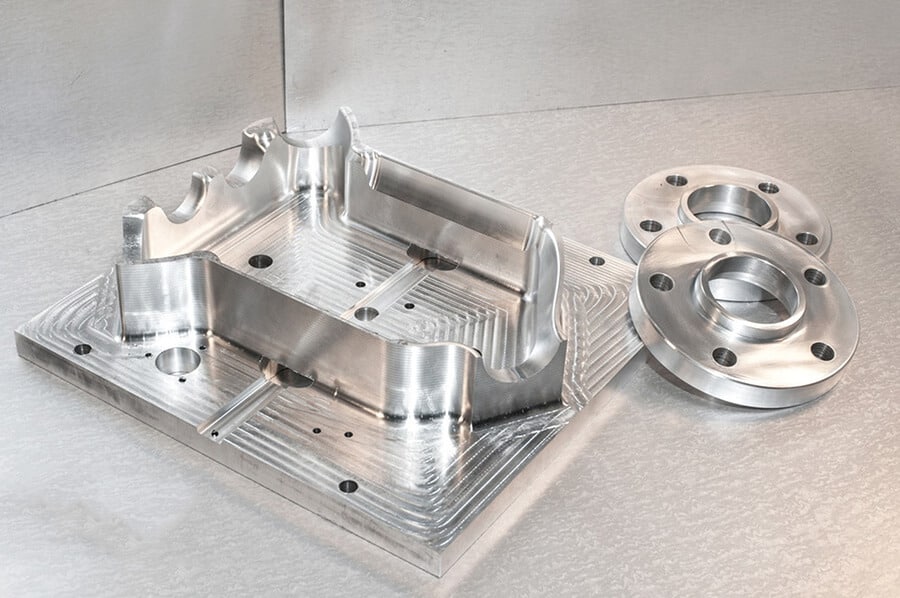
What are the Benefits of Cast Aluminum?
Cast aluminum alloys are commonly used in various industries due to their favorable properties. Here are some benefits of utilizing these types of aluminum in your project.
Versatility
Cast aluminum alloys offer greater versatility compared to machined aluminum alloys that are already finished parts. This is because cast aluminum can be machined, allowing for more flexibility in their applications.
Low cost
Cast aluminum is an economic option as it offers a lower investment cost compared to the CNC equipment used for machined alloy making.
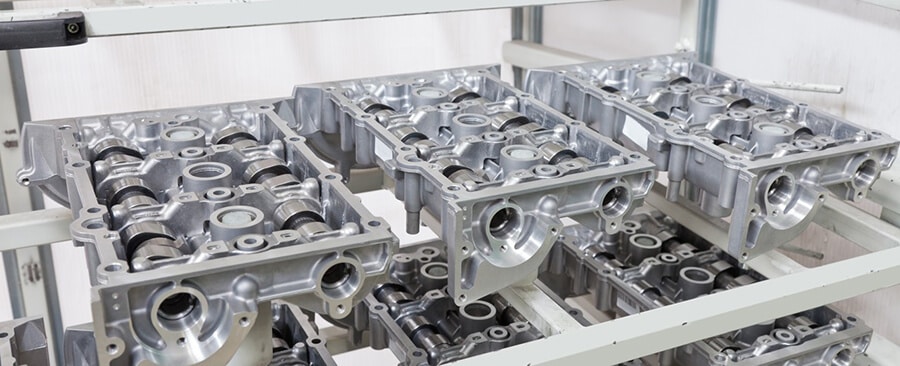
Long lifespan
Cast aluminum has a long lifespan because it has excellent resistance to rust, which helps to prolong its durability. Additionally, cast aluminum offers high resistance to wear and tear, reducing the need for frequent maintenance and resulting in lower overall maintenance costs.
Sustainability
Cast aluminum is environmentally friendly because it can be recycled. The waste material from cast aluminum can be utilized in the casting process, making it a more sustainable and eco-friendly option.
Conclusion
Aluminum parts come from different manufacturing processes boasting unique characteristics and performance that are suitable for different applications. This article provides a detailed guide on two types of aluminum products: CNC machined aluminum and die cast aluminum.
To summarize, machined aluminum is preferred when applications require greater precision, lightweight, and high strength due to its higher strength-to-weight ratio, consistency, and complexity than cast aluminum. On the other hand, cast aluminum is much cheaper to produce owing to its simpler process, making it a more economical option for applications where strength and durability are more crucial.
Ultimately, when deciding between cast aluminum and machined aluminum for your project, it is essential to consider your specific needs and budget to determine which option is most suitable for your specific projects.
Aluminum CNC Machining and Aluminum Die Casting – Runsom Precision Can Help
At Runsom Precision, we’re specialized in producing high-quality machined aluminum parts and cast aluminum parts with over ten years of expertise in aluminum CNC machining and die casting services. Our team of highly skilled engineers and machinists can help you find the perfect solution for your aluminum machining needs and create aluminum parts that exactly match your specifications. Reach out to our experts right now for an instant quote and let us help with your project!
Other Articles You May Be Interested in:

